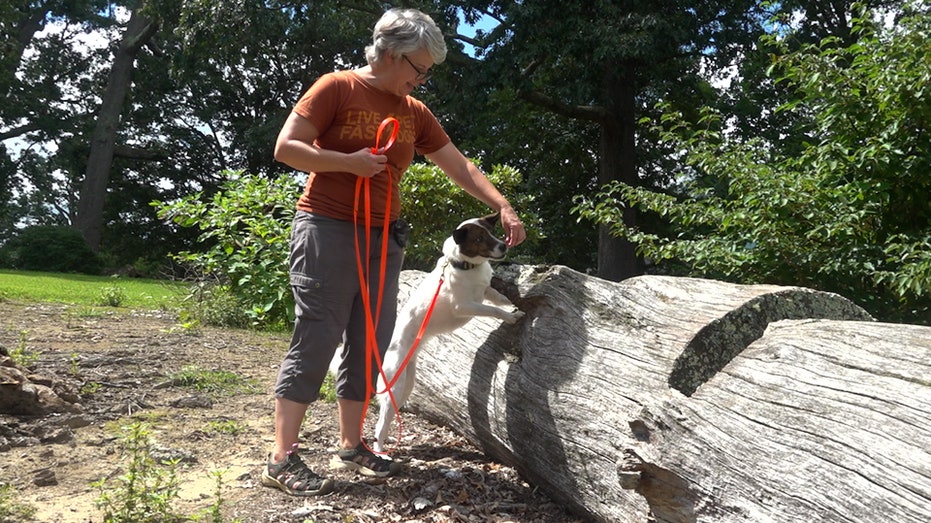Science
Dogs Join the Fight Against Invasive Spotted Lanternfly

Researchers at Virginia Tech have discovered that dogs can play a crucial role in detecting the invasive spotted lanternfly, a pest that threatens various crops across the United States. This innovative study highlights the potential of trained dogs to locate the insects’ egg masses, which are often difficult for humans to spot.
Training Dogs to Combat a Growing Threat
The spotted lanternfly, native to Asia, was first identified in the United States in Pennsylvania over a decade ago. Since its introduction, it has expanded its territory, impacting agriculture in 19 states, particularly in the Midwest and Northeast, according to the U.S. Department of Agriculture (USDA). These pests feed on numerous plants and excrete a sugary substance known as honeydew, which fosters mold growth and can devastate crops.
As concerns about the spread of the spotted lanternfly grow, Virginia Tech researchers have turned to man’s best friend for assistance. The study involved training dogs to detect the scent of lanternfly egg masses. Participants included Katie Thomas and her nine-year-old pitbull mix, Finch, who utilized their previous scent work experience to aid in the effort.
“Dogs have one dominant sense. It’s their nose. We use our eyes. Dogs use their nose like their eyes,” said Thomas during the study. She expressed the joy of combining fun activities with a significant community issue.
Promising Results from Field Tests
Throughout the study, dogs underwent both indoor and outdoor tests to identify the egg masses. Impressively, dogs correctly identified the lanternfly scent more than 80% of the time during indoor tests. In outdoor conditions, they maintained a success rate of over 60%, outpacing many human searches.
Another participant, Carolyn Shelburne, and her nine-year-old border collie, Hermes, were among the first teams to pass their field tests. Shelburne emphasized the importance of searching for egg masses before the lanternfly hatches, stating, “The problem is it’s too late once we have the lanternfly.” Their success reflects the capabilities of trained dogs to assist in environmental conservation.
The study saw participation from 182 volunteer teams across the country, indicating a growing interest in using canine assistance for ecological protection. “Hopefully, more people will see that you can train any dog to do this, and it gives you something fun to do with your dog,” Shelburne added.
As the fight against invasive species continues, researchers are optimistic that this initiative will pave the way for training dogs to detect other harmful pests and invasive plants. The potential applications extend beyond the spotted lanternfly, demonstrating a proactive approach to environmental conservation through innovative methods.
This collaboration between researchers and dog owners exemplifies how community involvement can lead to effective solutions for pressing ecological challenges. With the right training, dogs may soon become invaluable allies in the battle against invasive species.
-

 Technology5 months ago
Technology5 months agoDiscover the Top 10 Calorie Counting Apps of 2025
-

 Technology3 weeks ago
Technology3 weeks agoOpenAI to Implement Age Verification for ChatGPT by December 2025
-

 Health3 months ago
Health3 months agoBella Hadid Shares Health Update After Treatment for Lyme Disease
-

 Health4 months ago
Health4 months agoAnalysts Project Stronger Growth for Apple’s iPhone 17 Lineup
-

 Health4 months ago
Health4 months agoErin Bates Shares Recovery Update Following Sepsis Complications
-

 Technology5 months ago
Technology5 months agoDiscover How to Reverse Image Search Using ChatGPT Effortlessly
-

 Technology3 months ago
Technology3 months agoElectric Moto Influencer Surronster Arrested in Tijuana
-

 Technology5 months ago
Technology5 months agoMeta Initiates $60B AI Data Center Expansion, Starting in Ohio
-

 Technology2 months ago
Technology2 months agoDiscover 2025’s Top GPUs for Exceptional 4K Gaming Performance
-

 Technology5 months ago
Technology5 months agoRecovering a Suspended TikTok Account: A Step-by-Step Guide
-

 Health5 months ago
Health5 months agoTested: Rab Firewall Mountain Jacket Survives Harsh Conditions
-

 Lifestyle5 months ago
Lifestyle5 months agoBelton Family Reunites After Daughter Survives Hill Country Floods




















